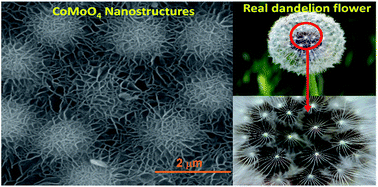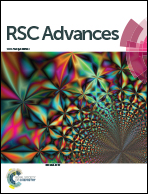An advanced asymmetric supercapacitor based on a binder-free electrode fabricated from ultrathin CoMoO4 nano-dandelions†
Abstract
Fabrication of nanostructures with controllable size and morphology is an important area of research and technology. This article aims at demonstrating a facile, low cost and reproducible mild hydrothermal procedure for the synthesis of dandelion-shape cobalt molybdenum oxide nanostructures (CoMoO4). Interestingly, CoMoO4 supported on a nickel foam (NF) substrate appeared in the dandelion-shape (ND) and ordered nano-arrays. Morphology characterizations and electrochemical investigations of the ND-CoMoO4/NF were carried out using different electron microscopy, spectroscopy and electrochemical techniques. A maximum specific capacitance of 2100 F g−1 at a discharge current of 1 A g−1 was calculated for the ND-CoMoO4/NF electrode in KOH solution. Notably, more than 92% of its initial capacitance was maintained after 3000 successive charge/discharge cycles. Moreover an asymmetric supercapacitor (ASC) assembled using ND-CoMoO4/NF in combination with the rGO/NF electrode. It was observed that the specific energy of the ASC only decreases from 26 to 21 W h kg−1 when the specific power increased from 1821 to 6580 W kg−1. Our findings indicate that the dandelion-shaped CoMoO4 nanostructures can be applied as a promising material for making high performance electrochemical capacitors.


 Please wait while we load your content...
Please wait while we load your content...